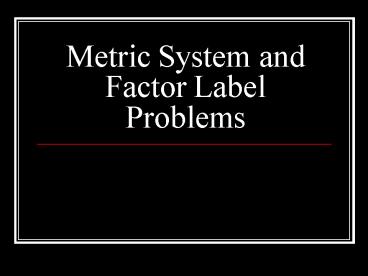Metric System and Factor Label Problems PowerPoint PPT Presentation
1 / 21
Title: Metric System and Factor Label Problems
1
Metric System and Factor Label Problems
2
Units
- The system of units used in chemistry is the SI
system (Systeme International) - This is related to the metric system
- There are base units for length, mass, etc.
- There are decimal prefixes that modify the base
unit
3
What is the metric system?
- Used in nearly every country in the world
- Was devised by French scientists in the late 18th
century to replace the chaotic collection of
units then in use. - The goal of this effort was to produce a system
that uses decimals rather than fractions.
4
What types of units are used for measurements?
- Mass - g, kg, mg
- Length - m
- Time - sec
- Temperature - K
- Volume - cubic cm (cm3)
- - liters
- - milliliters
5
- Prefix Symbol Factor (see more pg 14)
- Giga G 109 1 Gm 109 m
- mega M 106 1 Mm 106 m
- Kilo k 103 1 Km 103 m
- Meter Liter Second Gram
- Deci d 10-1 10 dg 1 g
- Centi c 10-2 100 cg 1 g
- Milli m 10-3 1000 mg 1 g
- Micro µ 10-6 1000000 µg 1 g
- Nano n 10-9 10-9 ng 1 g
- Pico p 10-12 10-12 pg 1 g
6
3 important calculations to have memorized
- Mass 1 pound 0.4536 kg (453.6 g)
- Volume 1 quart 0.9464 dm3 (0.9464 L)
- Length 1 inch 2.54 cm (exact)
7
Temperature conversions
- There are three temperature scales that you need
to be able to convert between
8
Temperature and Heat are not the same thing
- Temperature
- A measure of the average kinetic energy of random
motion of the particles in a substance - Heat
- A measure of the total amount of energy
transferred from an object of high temperature to
one of low temperature
9
Temperature
- Most commonly, we in the US use Fahrenheit to
report temperature - Where 32oF is freezing and 212oF is boiling
- But, most of the world measures temperature in
Celsius - Where 0oC is freezing and 100oC is boiling
10
Converting Fahrenheit and Celsius
- oC 5
- ----- ( oF 32)
- 9
- oF 9
- ----- ( oC) 32
- 5
11
Kelvin
- Many times, especially in working with gases,
chemist use the Kelvin scale - Where water freezes at 273.15 K and boils at
373.15 K - Absolute zero 0 K point at which all
molecular motion ceases - No negative numbers
- Convert from Celsius
- K oC 273.15
12
Why do we need to know the metric system?
- We use the metric system numbers for conversion
factors - We use them to change from one unit into another
unit
13
Information to know for the metric system and
conversions
- Milli- 1m 1000 mm 1 g 1000 mg
1 L 1000 mL - Centi- 1 m 100 cm 1 g 100 cg
1 L 100 cL - Deci- 1 m 10 dm 1 g
10 dg 1 L 10 dL - Standard 1 m 1 meter 1 g 1 gram
1 L 1 liter - Kilo- 1000 m 1 km 1000 g
1 kg 1000 L 1 kL
14
Dimensional Analysis
- Method for setting up mathematical problems
- Also called factor label method
- Problems that give you one type of unit and ask
you to convert to a different unit
15
Example
- You are asked to find out how many seconds are in
1 day. - How would you go about solving this?
- Step 1 Always write out the given number and
unit over 1 (make it a fraction)
16
Example continued
- Step 2 We are trying to cancel the unit we have
in order to get the one that is desired. So,
list all of the conversion factors that you know
about your given unit and decide which one you
should use.
17
Example Continued
- Step 3 Write your conversion factor(s) correctly
so the units you do not want cancel out and you
are left with your desired units
18
Example finished
- Step 4 Once you have everything written down,
you will multiply the numbers together. - Multiply everything across the top. Then
multiply everything across the bottom. Then
divide. - Get your mathematical answer and then round to
sig. figs.
19
Remember
- The units must cancel!
- Make sure that the answer is a reasonable one!
20
Example
- Convert 2.3 miles to centimeters
21
Example
- You mass a piece of iron in the lab. Its mass is
1502 g. Lets say that you need to record the
mass in kg, how would we do this?

